Traditional Ecological Knowledge Meets Modern Water Science
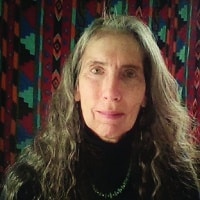
By Jacqline Wolf Tice
When you picture this area of Chester County, the Christina River watershed, White Clay Creek, a thousand years ago before the English, French, and Dutch found the Chesapeake Bay, it was teeming with Indigenous tribes all within a territory called the Lënapehòkink (also called the Lenapehoking).
Stroud Water Research Center sits in the southern tier of the Lënapehòkink, the traditional name of the ancestral lands of the Lenape (also called Delaware) people, whose presence here is archaeologically documented for 12,000 years. They lived near the water, harvested from the water, were nurtured by the water, and communed with the water.
Although overt evidence of Indigenous communities has been sparse here in the last 250 years, there are pockets of thriving Native communities who descend from the Delaware River Basin, inclusive of southern New York, Pennsylvania, New Jersey, and Delaware. By name, they are the Delaware Nation, Delaware Tribe of Indians, and Stockbridge-Munsee Band of Mohicans, Nanticoke Lenape Nation of New Jersey, Powhatan Renape Tribe, Ramapough Lunaape Nation of New Jersey, Nanticoke Tribe of Delaware, and the Lenape Indian Tribe of Delaware.
“In the past two years, the Stroud Center has initiated a dedicated purpose of building bonds with Indigenous communities to assist them with freshwater science and education and to learn from Indigenous communities how we can all better connect and become responsible stewards of water and the earth.”
—STEVE KERLIN, STROUD CENTER DIRECTOR OF EDUCATION
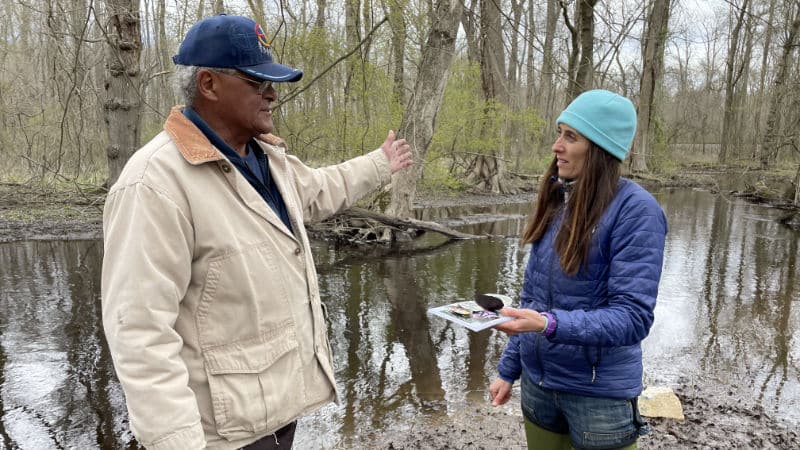
“We are Unalachtigo – people next to the big water. This project is about helping us to reconnect to water as our existence. Ongoing water science support is part of the Stroud Center’s important role in that goal.”
— Tribal Chief Dennis Coker, Lenape Indian Tribe of Delaware
Unalachtigo — People Next to the Big Water
In the St. Jones watershed, a young bald eagle flies over a grove along Fork Branch near Cheswold, Delaware. She circles four times above our gathering of six volunteers and then flies off to the south. It was a good sign and inspiring to behold while visiting the Lenape Indian Tribe of Delaware to discover more about their watershed restoration project with the Stroud Center, and other efforts to reclaim and honor the sacred lands and waters of their ancestors.
Since gaining recognition as a tribal government from the state of Delaware in 2016, they have actively engaged with universities and organizations on water and forest conservation projects that blend traditional ecological knowledge — that is, Indigenous knowledge gained over hundreds or thousands of years about local resources — with modern scientific methods of environmental assessment, water research, and land management.
At the edge of the Little Union Cemetery is a half-acre plot of wooded freshwater wetlands. The land was donated to the tribe in the 1990s, and after three years of steady work by tribal youth and community volunteers, it includes a walking path, talking circle, and native plant species like sassafras and mountain mint.
Tribal Chief Dennis Coker says this land is intended to be an edible forest garden for the Lenape community. “Originally,” Coker explains, “this area had agricultural mismanagement, with collector streams edging farm fields that contained fertilizer” doing damage to stream ecosystems. The waters of this region would have once supported a Lenape food culture that included freshwater mussels. Today, mussels are one of the most imperiled freshwater faunal groups in the world, and their status in the tributaries of the St. Jones and Leipsic watersheds was unknown until recently.
The eastern elliptio mussel (Elliptio complanata), one of the historically known species in the Delaware River Basin, has been detected in Fork Branch.
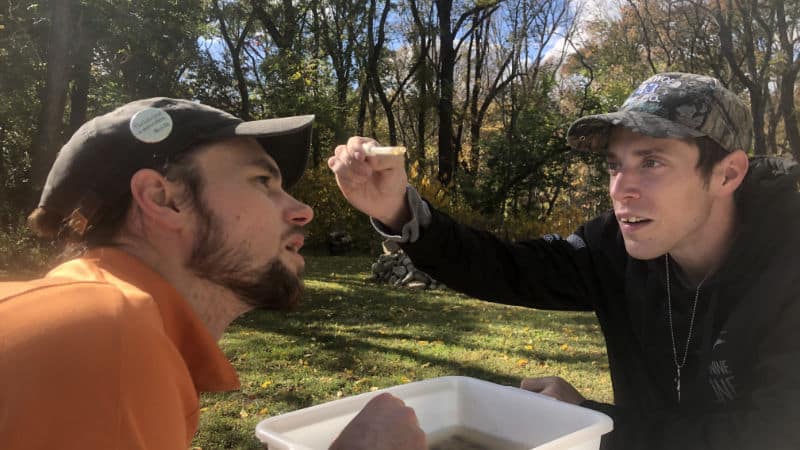
Assistant Director of Education Tara Muenz has been collaborating with tribal members to look for mussels in both of these watersheds. The effort is part of the Stroud Center’s initiatives activating science-based monitoring to support Indigenous communities’ values and water stewardship. Initial surveys from this project showed that the eastern elliptio mussel (Elliptio complanata) is present in small populations within Fork Branch.
For Chief Coker, part of his purpose as a tribal leader is, he says, “to keep people cognizant of who they are and how unique they are.” He continues, “We are Unalachtigo — People Next to the Big Water. This project is about helping us to reconnect to water as our existence.” Ongoing water science support is part of the Stroud Center’s important role in that goal.
Seneca Nation of Indians — Beginning the Day With Ganö:nyög
A similar sentiment exists among the Seneca Nation of Indians on the Allegany and Cattaraugus territories in western New York. The Stroud Center began working with the Allegany community in 2022. Seneca members Chelce Finch and Liz Smith, the respective director and assistant director of the Seneca Arts and Learning Center, introduce themselves by their clans as is traditional in their tribal community. The learning center serves as an infant-to-preschool-age daycare, Head Start, and essential after-school facility for approximately 60 children, mostly from the Seneca Nation. It is a place that integrates Seneca culture and language in all lesson plans, even in lunch menus!
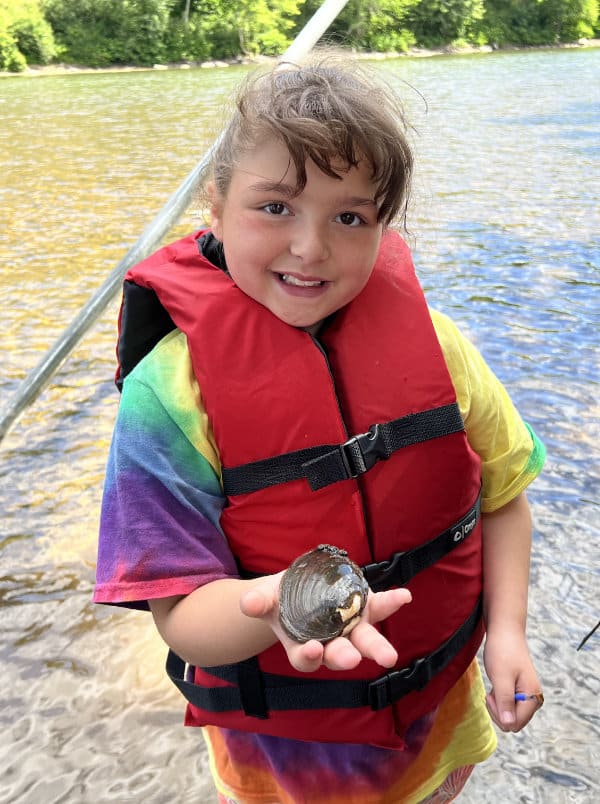
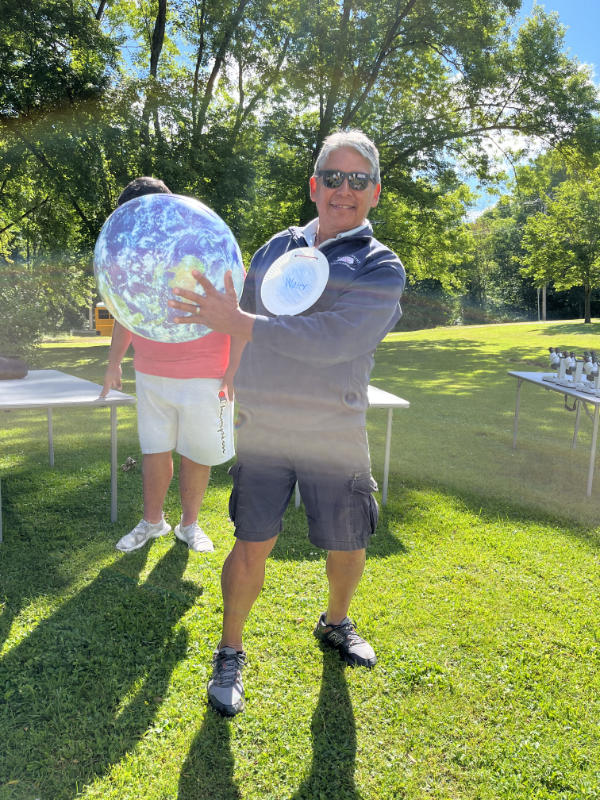
Mike Gates, director of emergency management for the tribal nation, was researching water management equipment for the Seneca when the Stroud Center’s work came to his attention. He was especially attracted to the Stroud Center’s youth outreach programs. For the Seneca, Gates explains, a youth program makes sense, as “the planet is left in their care, the children will bring the water teachings into the future.” Through a Bureau of Indian Affairs grant, Gates says he created the Water Protectors program to get Seneca children “out of the classroom and into the water.”
By pairing scientific methodology and meaningful watershed education with cultural teachings, the initiative augments traditional ecological knowledge with modern water science.
Along the Allegheny River, the day starts with the Ganö:nyög, the Thanksgiving Prayer of the Seneca, which addresses and acknowledges 22 elements in the world — gifts of the Sky-world to this Earth, to teach a way of seeking the unity of all things — the good mind. Water is one of the special elements acknowledged ceremonially each day.
Ganö:nyög
The Thanksgiving Prayer of the Seneca, which addresses and acknowledges 22 elements in the world. Water is one of the special elements acknowledged ceremonially each day.
Muenz and Gates’ connection was so immediate and “heartfelt,” says Muenz, that she and her education colleagues from the Stroud Center were invited to take part in this daily cultural remembering. It was an honor and source of internal meaning for Muenz. “Water is my family,” says the aquatic biologist; “sharing this deeper ceremonial connection allowed me to feel and express my deep connection and appreciation of water in community with the Seneca.” Integrating with the cultural aspects of the Seneca created a meaningful experience for the tribal community members who participated in the Stroud Center’s various activities at the river.
The Stroud Center’s participation in the Allegany Territory of the Seneca Nation has been in and at the river, according to Smith and Finch, who both acknowledged that the Stroud Center showed them how to make each activity developmentally appropriate for each age.
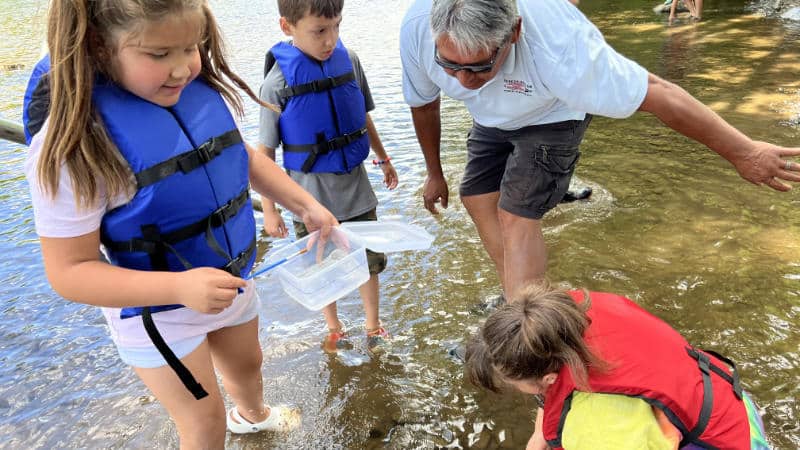
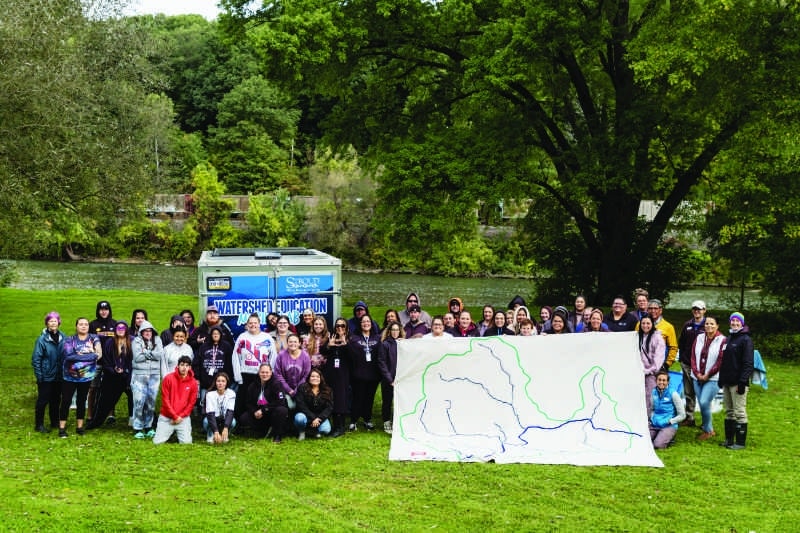
The professional development training offered by the Stroud Center introduced 40 teachers and 10 outside participants to an array of water engagement and learning tools through the nationally recognized “Getting Little Feet Wet” curriculum of the Project WET Foundation. According to Smith, prior to this training, the learning center “used water strictly for sensory play. This training demonstrated other domains as well: fine motor, gross motor, cognitive, and socio-emotional skills. It allowed us to see how this beautiful natural resource can be brought into the classroom and used to expand these other areas.” At the end of the last session of the year, the Stroud Center provided each classroom with a toolkit of instructional supplies to deliver and enhance the practice skills learned through the curriculum.
Learning about water through scientific methods and connecting to water as a source of ancestral significance has strengthened a throughline of cultural continuity for the Seneca Nation and the Lenape Indian Tribe of Delaware. Reiterating the words of Autumn Peltier, for Indigenous cultures, “water is a living being.” By conducting these trainings, demonstrating respect for specific cultural values, and taking the lead from the tribal communities themselves, the Stroud Center has established a bond with these communities in what is just the beginning of a long road together nurturing the good mind.
Get Involved
The Stroud Center offers a variety of education programs. When you find one that’s right for you, start the registration process here and the education team will reach out to you.
Jacqline Wolf Tice is an Indigenous legal scholar, graduating summa cum laude from the University of Oklahoma’s Indigenous Peoples Law program. As a nonmember, she is affiliated with both Cherokee and Mandan Hidatsa Arikara tribal communities. She is an adjunct and course manager for the University of Oklahoma College of Law and, as a cultural ecologist, writes on issues of sovereignty at the intersection of culture and the environment. She is a Penn State Extension Master Watershed Steward volunteering with the Stroud Center’s EnviroDIY water monitoring project in the Delaware Water Basin. She is also the author of Native American Heritage Month: From Acknowledgment to Understanding to Truth Telling and The Relativeness of Water.



